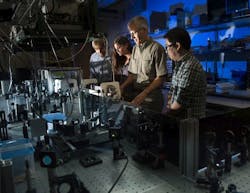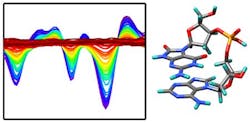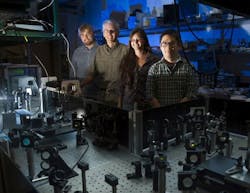Femtosecond IR laser setup helps explain how DNA avoids damage from UV light
Thanks to an ultrafast laser setup, an international team of researchers at Montana State University (MSU; Bozeman, MT), the University of Utah (Salt Lake City, UT), and the Institute of Biostructures and Bioimaging (Naples, Italy) has found how DNA responds when exposed to ultraviolet (UV) light. The findings advance fundamental understanding of DNA damage by the UV rays found in sunlight, which can lead to skin cancer, aging, and some degenerative eye diseases.
Related: Terahertz pulses cause DNA damage while inducing DNA repair
In the research team's experiments, the researchers observed the earliest events immediately after DNA is energized by UV radiation—events that determine whether or not DNA is damaged, explains Bern Kohler, an MSU professor in the Department of Chemistry and Biochemistry and one of the study's co-authors.
DNA is generally able to stand up to UV rays, but UV rays sometimes cause mutations. Too quick for the eye to see, UV light causes an electron to be transferred from one base to another on a single DNA strand. A base is the smallest unit of the genetic code, a small molecule that constitutes an individual "rung" on DNA's ladder.
In a next-generation solar cell, light also transfers electrons, but in DNA, the researchers observed that the transferred electron returns to its starting point in a femtosecond. The back-and-forth motion of the electron explains how DNA remains undamaged most of the time. At the same time, the researchers note that the transferred electron could be used to repair damage in a way that mimics how certain repair proteins fix UV damage.
The new discovery was possible because of an infrared (IR) laser instrument built by Yuyuan (Tom) Zhang, an expert in ultrafast spectroscopy, a postdoctoral researcher at MSU, and first author of the study, Kohler says. The instrument shoots femtosecond pulses of UV light at DNA samples, then measures the vibrations created in DNA in response. By analyzing those vibrations, the research team was able to determine that one base in a single strand of DNA transfers an electron to an adjacent base on the same strand when excited by UV light (or radiation), Kohler says. He adds that molecules constantly vibrate and light absorption leads to even greater vibrations. Removing or adding an electron causes changes to the pattern of vibrations, and that is what the MSU team measured in the lab.
Full details of the study appear in the Proceedings of the National Academy of Sciences (PNAS); for more information, please visit http://dx.doi.org/10.1073/pnas.1404411111.
-----
Don't miss Strategies in Biophotonics, a conference and exhibition dedicated to development and commercialization of bio-optics and biophotonics technologies!
Follow us on Twitter, 'like' us on Facebook, and join our group on LinkedIn
Subscribe now to BioOptics World magazine; it's free!



